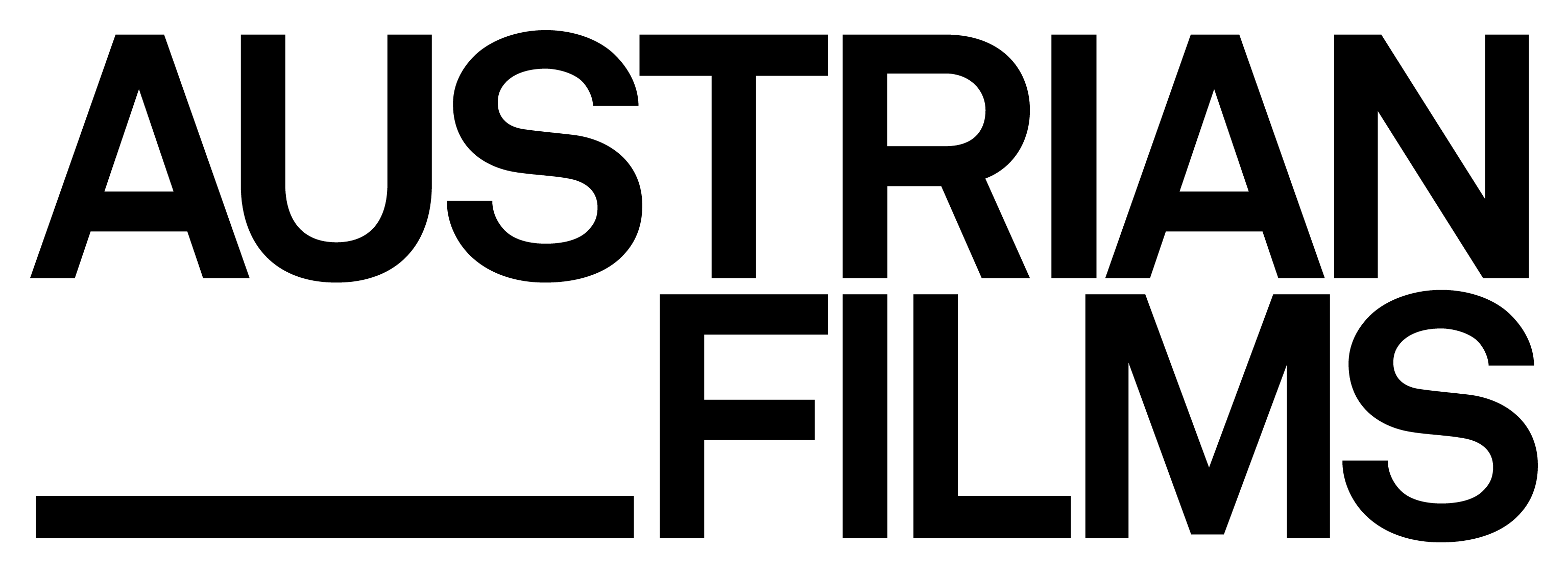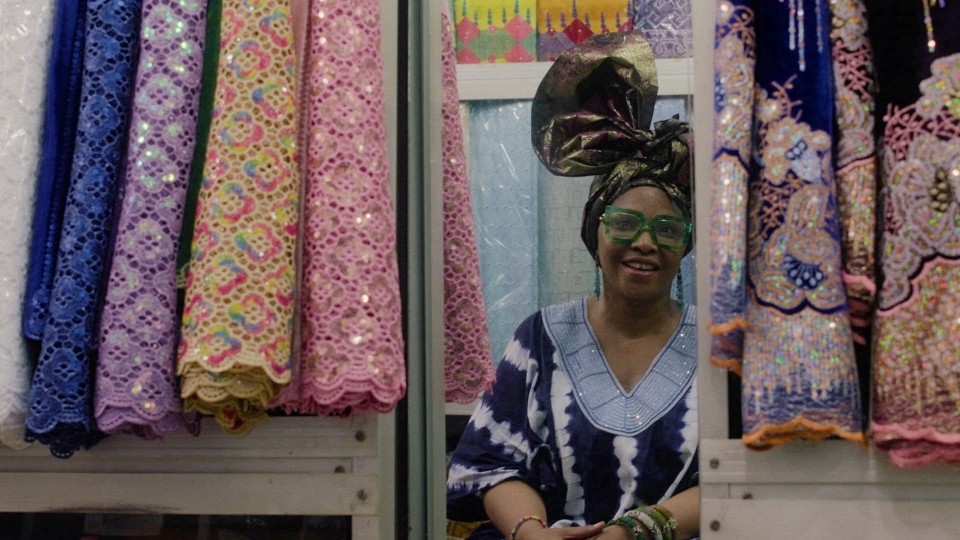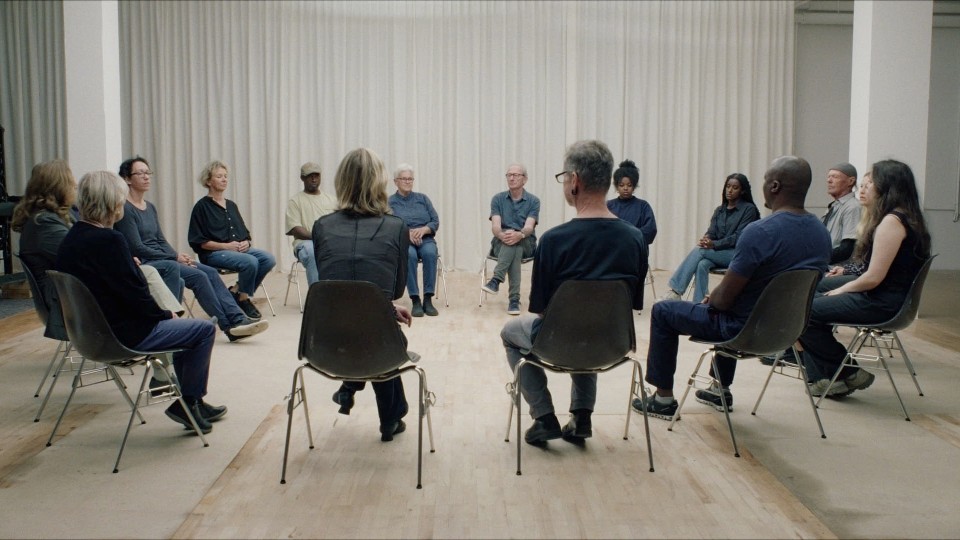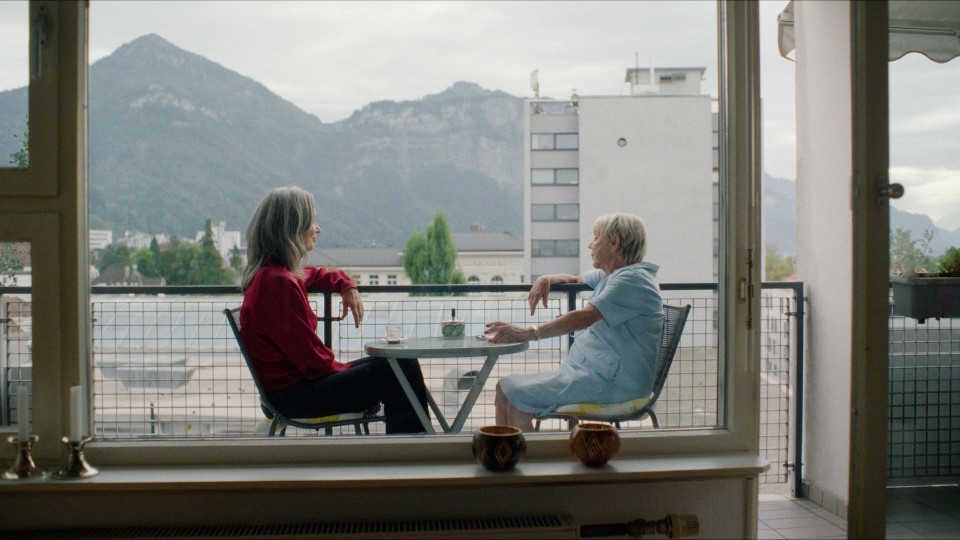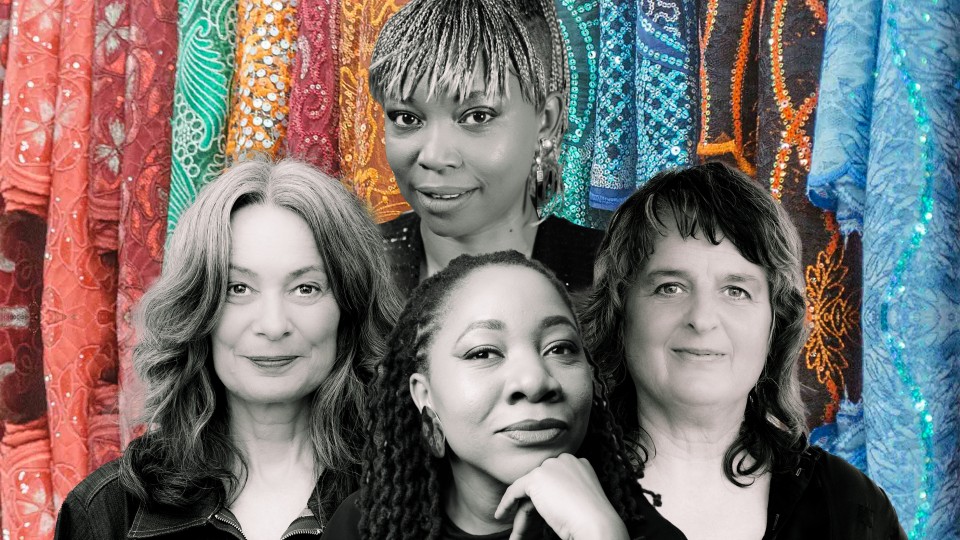Being interwoven, entwined, even entangled is in the nature of textiles. The thread that Anette Baldauf and Katharina Weingartner
pick up in LACE RELATIONS leads from the west of Austria to Nigeria, which has long been one of the Vorarlberg textile industry’s most lucrative markets.
The research they conduct leads to the unravelling of unexpected connections between prosperity in the Alpine region and colonial
power relations. In cooperation with Joana Adesuwa Reiterer and Chioma Onyenwe, a film was created from two perspectives,
between Lagos and Lustenau; as it unfolds, this two-sided material is revealed as a vehicle of capitalism and dominance, of
transformation and empowerment.
Anette and Katharina, you both come from Vorarlberg, where you went to school in the 1970s and 1980s. Can you tell us about
the perception of the Vorarlberg textile industry at that time? What was the narrative of your school days concerning this
region and beyond?
KATHARINA WEINGARTNER: It was definitely a “Schaffe, schaffe, Hüsle-Baua-attitude, meaning “We’re the most industrious people in the world,“our wealth
is solely due to our hard work, since we’re so exceptionally “flißig” (hardworking), right, Anette?
ANETTE BALDAUF: What was really unique for both of us, we grew up in Vorarlberg, but it was only in the course of our research that the whole
colonial history unfolded itself. We had never thought about it before. I guess it also says a lot about us. We have read
a lot about colonialism and slavery abroad, but we have never considered it as a foundation with regards to the culture we
came from.
What kind of insights, and perhaps encounters, resulted in this image beginning to crumble, so you felt the need to investigate
and make a film?
KATHARINA WEINGARTNER: Anette and I went to the Dakar Art Festival, where we also made a trip to the textile market. Before, we both had thought
that the presence of textiles from Vorarlberg had severely declined, and all moved to Asian production. To our surprise, there
were still so many Austrian labels to be found there. This was a starting point where we both began to think about where we
come from and what had happened right in front of our doorstep. Where does the wealth come from, thanks to which we both used
to explore themes far away from home on both, an academia level as well as on a filmmaking level. We started looking at our
doorstep, after so many years it was really about time to take a closer look at those conditions. I remember this as a very
sudden starting point for this film. What about you, Anette? Do you remember this day in Dakar?
ANETTE BALDAUF: Yes, I do. I guess, for me it was gradual with a lot of turning points. It depends on who is approaching the history – us
recognizing fairly late that the history of colonialism provides a foundation in Vorarlberg, I’m sure, for Joana this was
not really a surprise.
LACE RELATIONS has four directing credits for two filmmakers with roots in Vorarlberg and two with roots or lives centered
in Nigeria. Was the initial idea to look at the topic from two sideslike the front and back of a fabricin constant interaction?
KATHARINA WEINGARTNER: Maybe I can give a brief answer as a producer: When Anette and I started to think about conceiving a film on this topic, it
was clear from the very first moment that we would want the Nigerian part to be covered by creatives from there. Which is
a quite unusual procedure for an Austrian documentary production and not easy to do.
How did your directing team grow?
KATHARINA WEINGARTNER: It was quite a process and unusual for a film to take this life. It actually started out with a radio podcast for WDR with
Anette, Jumoke Sanwo from Lagos and me, before becoming a film. Jumoke, who is now part of Anette’s art and research project,
started to work on the script with Anette and brought a producer on board with whom we worked during the first year. I wanted
to co-produce with a producer from Nigeria, but it didn’t materialize, since our project turned out to be very time consuming.
Finally, we found our partners in Lagos, and first Joana and then Chioma came on board.
Joana and Chioma, what kind of questions or perhaps existing connections motivated you to get involved in this project?
JOANA ADESUWA REITERER: As a filmmaker, I also have a background in textile. Thanks to projects in the textile industry, I had this insight about
textiles, that was what prompted my interest. Then, the idea of the concept – we’re going to do two films and merge it – an
Austrian side telling the story from this perspective and the Nigerian side telling from that perspective, was intriguing.
It was a kind of a pilot approach in making a documentary. I grew up seeing my mother wear lace, me being based in Austria
as well, I knew about the whole Vorarlberg lace culture in Nigeria. There were so many bits and factors that got me to the
project.
Were you aware of the connection between Vorarlberg and Nigeria, or did you learn about it through the project?
JOANA ADESUWA REITERER: In Nigeria we all know about it. I think the most prominent one is “Swiss Lace”. People who are connected to the textile
industry know that even the ones they call “Swiss Lace” are Austrian fabrics because they are from Lustenau. As “Swiss” has
the higher end, even Austrian fabrics are branded “Swiss”. We all know about it. The colonial aspect is something that I explored
more during this project, trying to dissect how deep the connections are and what the connection looks like.
CHIOMA ONYENWE: I came to the project as a consultant. Katharina was looking for a mentor, which was intriguing to me because she is much
older than me. That’s how we got introduced. Katharina, as a director who’s also producing, needed a kind of strengthening
her producing muscle. I am a producer based in Lagos and also a director. What fascinated me when I saw the initial scripts,
there was something around how women’s interests kind of turned flimsy, even in Nigeria. Whether you want to open a spa or
sell lace, something that women do, is not an industry, nothing big. The beauty industry is actually a billion dollar-industry.
Realizing that the lace industry even though the benefits were being exported had achieved that kind of scale was fascinating
to me. My question as a Nigerian in Nigeria was more around consumerism, the scope of it and the industry that is built and
how it all comes around. In the end of the day, it’s always about who owns and who sells, it always boils down to economics
and capitalism and consumerism. These were the questions that fascinated me to come on board. Joana steered this ship in telling
the Nigerian story.
Once you were a team of four, how did you proceed in terms of methodology? How did your different backgrounds from research
and filmmaking merge?
ANETTE BALDAUF: In the beginning we researched quite separately, then we had lots and lots of meetings and discussions, fights, debates and
negotiation and ... again
fights (laughs)
It was an ongoing negotiation. And also an incredible learning experience. It
was really a challenge in terms of how to tell a story together.
Chioma and Joana, what were your premises for developing the setting in Nigeria? Was one of the initial goals to find a protagonist
with a link to the Austrian protagonist Grete Bösch, who was a lace trader in the 1970s and 80s? In choosing Ireti Bakare-Yusuf,
you appear to establish a connection to a prosperous period of lace trading through the commemoration of her mother Alhaja
Seriki-Yusuf, while at the same time portraying a second generation of forceful, activist Nigerian women?
JOANA ADESUWA REITERER: I also came on board as a consultant initially. Katharina and Anette already had a list of protagonists. Looking into what
was already on ground, Ireti seemed to be a very strong protagonist who bridges generations. She also has a very strong connection
to the economic system thanks to her mum, Alhaja Seriki-Yusuf who was a successful lace trader in Lagos. The parts of female
empowerment and the business that was built around it, that was core. Ireti could represent these different aspects, the culture
and the economical aspect. And she is very outspoken. The moment I got to meet Ireti, I immediately knew she was going to
be one of the protagonists. When we’re talking about this story of textile, it is beyond just the lace and the lace relations.
There are other fabrics that played a role and still play a role today. It was important to find protagonists who would represent
other kinds of textiles. Beyond Lace, fabrics such as Adire and Aso-Oke also embody African innovation, cultural identity,
and the lasting impact of colonialism.
CHIOMA ONYENWE: I guess, it was like bringing the story back home. A lot of it was about what we were losing. For a long time as well, in
the context of consumerism, things that come from outside could be valued higher, I’m thinking of this conversation about
Nigerian lace being tagged Austrian lace. Now the tide is turning, in culture, with music, with fashion. Being Nigerian, being
African is cool, wearing our own fabrics is cool. Adire is making a comeback. What happened in the past lies within Austria,
we are very forward facing. Having Ireti was a very strong choice, she is a journalist and with her mother as being part of
the trade, we have somebody to question authority. There were things that were planned, but there were things that happened
as a result of the energy being different. In Lagos, there’s a lot of energy, a lot of movement, a lot of noise. This kind
of shines through in the film, with Austria in contrast ...
it’s pretty (laughs), but it’s quiet
You have to sit, sit
with thoughts
, but we want to act. The film is also showing these two kinds of energy.
Katharina and Anette, you chose sociodrama as the means of examining how the textile industry in Vorarlberg functions. Why
did you choose this method, and what are its advantages in this particular context?
ANETTE BALDAUF: We really struggled with finding the right form. The major challenge that we confronted had to do with the fact that we wanted
to address a history of violence without reproducing the violence. We did not want to do interviews, not interact in any way
with this very upfront racist discourse that we would have encountered if we had talked with some of the manufacturers etc.
We continuously struggled with finding a form that would not reproduce this kind of racism but still somehow allow us to work
through it. This kept us searching for a couple of years. Somehow we got in contact with people who worked with the sociodrama
and then all of a sudden, it was clear this is what we wanted to do.
KATHARINA WEINGARTNER: I’d like to add one thing: We are a part of the system and didn’t want to be in the position of a spectator from outside.
We’re within this. We wanted to create a form of communication within this group. And it took us at least a year to develop
the setting and to create a diverse group in a place like Vorarlberg. Even though I was not part of the sociodrama I felt
as if I had participated. Our crew was sitting behind the scene with the monitors and sometimes we all had tears running down,
since the feelings that came up were so instant. The group was able to address the pain. It only took three very intense days
and when we filmed it, it felt absolutely to the point. Some of the members wanted to continue, they felt how important the
process was and that it also offered the possibility for healing. It was a very interesting experience for all the participants.
And we will continue the sociodrama within a Citizen Science project that will start this autumn and last eight months.
ANETTE BALDAUF: My feeling is, it’s about addressing the violence, attending to this history that has been totally erased, trying to spell
it out, address the different elements of it.
How did you cast the participants in the sociodrama group?
KATHARINA WEINGARTNER: Firstly, we were looking for people from the industry, which was difficult, since a lot of people in Vorarlberg are used to
not speaking about what happened. And want to keep it that way. We wanted to include workers. The production in the textile
industry was done from very early on by workers from Turkey. Vorarlberg was one of the first areas in Austria with a massive
influx of Turkish workers who lived under horrendous conditions in the beginning. When I went to school there was an incredible
segregation which holds on until now. We wanted to include this form of violence. And also workers who come now to Vorarlberg,
a lot of them from African countries. The society in Vorarlberg has not yet adopted inclusion and diversity and is still very
segregated.
ANETTE BALDAUF: And we also tried to work cross-generational.
This might be the moment to spotlight your Austrian protagonist, Margarethe Bösch, who opens and closes the film.
ANETTE BALDAUF: There’s no question that she is an incredibly brave and determined woman. We were very lucky to have her in the sociodrama,
she also a very strong character there. What’s important in the sociodrama, there’s no good and evil, there’s a lot of shades.
KATHARINA WEINGARTNER: And also the fact that she worked in a very male dominated industry. She was the only woman within a bunch of guys to go on
those business trips. She participated in this business, but she also lifted the veil and broke through the censorship. There
are many people who do not talk to her anymore in Vorarlberg since the publishing of her book, Margret’s African Connection. And I’m happy we bring a woman of her age on the screen. I appreciate her open-mindedness, and also her interaction with
Ireti.
That brings me to a moment in the film after Grete met with Ireti: Ireti mentions feeling a kind of guilt, because she is
the beneficiary of a system that gave her mother prosperity. The success of lace in general had also led to a decline of the
local textile industry. Apart from the colonial involvement of the Vorarlberg textile business, as the core revelation of
the film, for me this scene opens up another takeaway of LACE RELATIONS, showing how comfort blinds us to the fact that one
person’s benefit comes at the expense of someone else.
ANETTE BALDAUF: We tried to portray complex personalities, complex lives, acknowledge ambiguity and complexity. The challenge we encountered
ongoingly was to not get stuck in making a comparison of supposedly two parallel stories. We tried to have two separate stories,
even though they crossed. There is a lot of entanglement but also differences with regards to the challenge that these two
women have to confront, the ghosts that are haunting them. Grete talks about those ghosts. For Ireti it’s a very different
situation.
KATHARINA WEINGARTNER: I like the moment in which Ireti acknowledges this complicity. I think it’s one of the strongest moments in the film.
JOANA ADESUWA REITERER: The aspect of Ireti feeling guilty about her mother’s involvement in history, this is not how I felt it. The intention was
just to observe the relationship between the fabrics and what it means to us in Nigeria. The fabric meaning, of course consumerism,
but also culture. If Ireti evolves beyond the idea that she had, the memories of the lace being the extravagant beauty thing
to show off – because it was our initial intention to commemorate her mum – still leaves that idea of this luxury life. But
then the transformation of her, I wouldn’t say it’s guilt, the transformation of her saying this is still going to empower
the system that oppresses us. She is not her mum’s generation, but this is still, if I represent my culture, my commemoration
just with this Austrian lace, it is still going to uphold the narrative that that’s still of more value than us. The transformation,
the introspection of Ireti like “Oh, I actually come from a culture where we have handwoven fabrics that have much more value,
I come from a culture where they still do make fabrics, yes, it has died over time, but this is now an opportunity for me
to embrace my identity even more.” It’s a sort of journey of Ireti going back to her roots. That’s why you get to see her
really fighting for this fabric and you see her explore the Adire fabric with the other protagonist. For us, it’s not the
guilt,
, and this is something that for us was so important to be careful with, not to translate the colonial guilt and reduce
the economic impact and empowerment that her mother had brought. For us it was important to make sure that we leave that colonial
guilt in Vorarlberg and really focus on the socio-economic impact it has. Her mum is just representing many other women. So
if it was men building these industries there, we would be talking about the multimillion dollar business they made. We wouldn’t
be only talking about creative soft power. I’m happy that also Chioma was able to find more women representing textile innovation
in Nigeria.
For us it’s another story even if the world intersects, that’s the world we all live in, but we still have another story.
This is a journey to our self-introspection and to appreciate the things that we have.
ANETTE BALDAUF: I suspect that Ireti considers lace Nigerian. For her, even though it’s not manufactured there, the cultural value is produced
in Nigeria. She called me today asking whether I could find out who’s taking over Rudi Bösch’s factory – an Austrian, who
recently died and had previously run a lace factory in Nigeria. She wants to protect it, because it is Nigerian. It doesn’t
matter whether Rudi was Austrian, the factory is Nigerian, the lace is Nigerian.
JOANA ADESUWA REITERER: Without Africa you wouldn’t have that industry because in Austria nobody wears lace. It’s an important aspect of the whole
film that, even in Nigeria, we realize the cultural and commercial power that we have, the power that we transform European
villages into an industrial complex, that’s even for Ireti – I can’t speak on her behalf – something we got to see during
the process of making the film, the power that we have. This can’t be reduced to consumerism, we make the culture. We can't
always just reduce it to that because there is the technical expertise in production, there is technical expertise in transforming.
How much value do five yards of lace have? It doesn’t have a value, it’s the transformative power that we bring into it that
creates that value and if you watch the people at the event, you get to see different kinds of textiles being used. These
textiles don't have value except you bring them to life. And that’s what we do on the African continent. And that’s the impact
we want to communicate with the film.
The subject of fabric already involves the concept of interweaving, and on top of that, here you employ a twofold cinematic
approach. What were your premises for the editing process in this context?
KATHARINA WEINGARTNER: It was a very complex process, also communication-wise. We did a lot of what we’re doing right now
without Zoom this film
wouldn’t have been possible. We worked in the editing studio in Vienna, sent rough cuts to Nigeria and then had meetings on
Zoom. One thing that Anette and I learned during this long process: Joana and Chioma always insisted on the fact that the
colonial aspect was ours, and that their themes were different. From the scriptwriting on, during the shooting and the editing,
this was one of our struggles. Anette and I had to find the story within our story and then still find connections with the
Nigerian story. It took much longer than planned and financed. From a producer’s perspective it was extremely challenging
to come to a final version within the budget we had at our disposal, and also as a filmmaker I reached some new grounds. It
helped a lot that Chioma was able to come to Vienna within the FC Gloria mentorship program and spend a week with us.
CHIOMA ONYENWE: One of the editors, Anabel Rodríguez Ríos came from a space where she also could relate to the subject matter. It was really
about conversation. In making the film and in seeing the script, in exploring so many different subject matters in different
places, the goal was not to be academic even though the subject matter is largely academic. When I talked to the editor it
was more about what feelings can come through the scenes. As for Joana’s work with Ireti, it was very much about exploring
the layers of the subject. From the style it was shot from the Nigerian side, it was close and personal – just think of the
scenes when she’s wiping off the make-up – it was about how the story can also reflect the person and not just the subject
and the topics. That might not be as fascinating to everybody. We had conversations around that, emails back and forth, it
was also about the concern that the editing doesn’t say something else. If we’re trying to portray something true, make sure
that what is trying to be said is not lost in translation, not lost in the editing and is not put in a way so that it reflects
a different narrative. In this process, Joana was like a Voltron of the characters, making sure that nothing reflects
editing
can be tricky, things can be put together and say something else. With Anabel we worked on questions such as: What does this
feel like? How does this come across? What are we trying to leave the audience with?
You mentioned earlier a new series of sociodrama sessions that will begin soon. Is the completed film now a kind of basis
for new and more far-reaching initiatives in a process of consciousness raising? Tell us more about the ongoing initiatives
and your expectations regarding the impact of the film.
ANETTE BALDAUF: The Archive of Economy in Vorarlberg is organizing a conference next year on Vorarlberg’s relation to colonialism. We had
interviewed them initially and they had told us that there was nothing to be addressed. So now they invited two historians
from the University of Innsbruck to dive into the archive, which, I think, is amazing. They will dedicate time and attention
to explore the subject matter and look into the Archive from a different perspective.
KATHARINA WEINGARTNER: We’ve been trying to get in touch with textile companies in Vorarlberg to launch this film together and continue the discussion
around these hidden themes. We didn’t want to come from outside and “invade” the region with our film. It’s been difficult.
We consider it a good sign that the Archive is planning this conference. The film will premiere in Vorarlberg in March 2026
as the opening film of the Human Vision Festival. I truly hope that we will find ways to talk to each other. We’ll try to
find access to this industry. There’s also a Lace Museum in Lustenau, where we shot parts of our film. The African content
there is minimal, that’s surprising and I don’t know why. Maybe there will be communication and answers and movement, once
we’re there with our film. Chioma and Anette are organizing a premiere in Lagos in early November during ART X and the Lagos
Fashion WeekAnd, of course, we hope for many festivals all over the world to show the film, since the textile industry has
left its marks in many societies, and I hope it can be translated to other situations and spark conversations.
CHIOMA ONYENWE: The screening in Lagos will be tied to the research project.
ANETTE BALDAUF: The research project is an artistic research project funded by FWF, the Austrian Science Fund. The artists Milou Gabriel,
Sasha Huber, Janine Jembere, Susanna Delali Nuwordu, Esther Ojo, Jumoke Sanwo, Mariama Sow, Katharina and me made an extensive,
16m long quilt that is a multi-sensory investigation into fabrics’ relation to history, memory as much as reconciliation and
joy. The exhibition Òwú. Fill. Faden. Thread took first place at the Vorarlberg Museum in Bregenz, then traveled to the Textile
Museum in St. Gallen, is now shown in Vienna, and then flies to Lagos and finally Dakar. In Lagos, it will open on October
29th curated by Jumoke under the theme “reclamation”, which was addressed by Joana and Chioma, meaning, reclaiming historical
textile making.
CHIOMA ONYENWE: On November 1, 2025 we’re planning our screening. And we’re working with the John Randle Center for Yoruba Culture and History
to showcase Alhaja and her story, which is part of our history. We’re hoping to have a good turnout at the screening and an
engaging conversation. Documentaries are not necessarily a diet for filmgoers in Lagos. That’s why it’s important to have
films that people can discuss and I’m excited about the opportunity to introduce the film to the audience.
Interview: Karin Schiefer
September 2025
